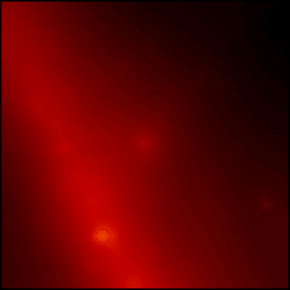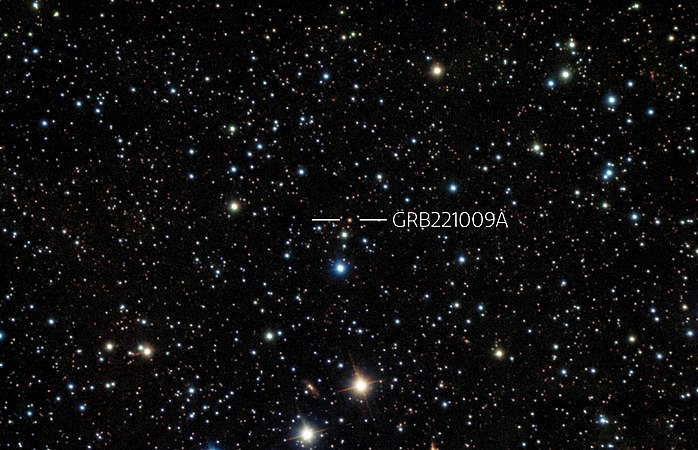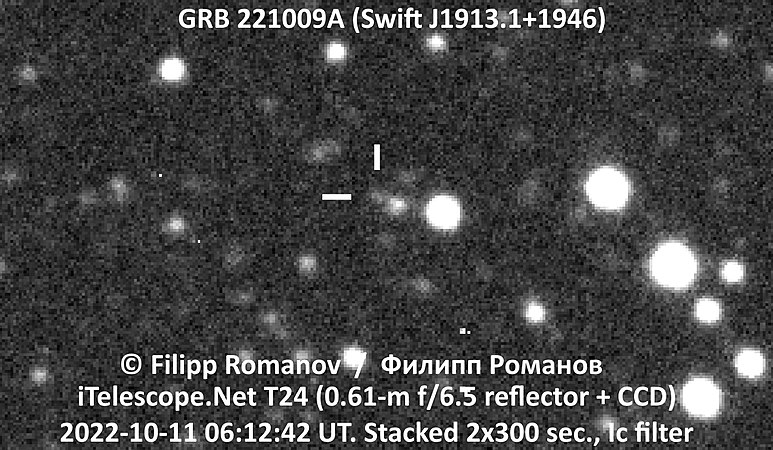| Revision as of 16:05, 22 May 2023 edit文爻林夕 (talk | contribs)142 editsNo edit summaryTag: Reverted← Previous edit | Revision as of 17:25, 22 May 2023 edit undoNerd271 (talk | contribs)Extended confirmed users15,796 edits Undid revision 1156386431 by 文爻林夕 (talk) Where is this from?Tags: Undo RevertedNext edit → | ||
| Line 12: | Line 12: | ||
| | distance = 2.4 billion ] | | distance = 2.4 billion ] | ||
| | redshift = 0.151 | | redshift = 0.151 | ||
| | names = Swift J1913.1+1946 |
| names = Swift J1913.1+1946 | ||
| }} | }} | ||
| {{Short description|Gamma-ray burst}} | {{Short description|Gamma-ray burst}} | ||
Revision as of 17:25, 22 May 2023
 Ten-hour timelapse of GRB 221009A, as seen by the Fermi Gamma-ray Space Telescope Ten-hour timelapse of GRB 221009A, as seen by the Fermi Gamma-ray Space Telescope | |
| Duration | 10 hours |
|---|---|
| Constellation | Sagitta |
| Right ascension | 19 13 03.48 |
| Declination | +19° 46′ 24.6″ |
| Distance | 2.4 billion light years |
| Redshift | 0.151 |
| Other designations | Swift J1913.1+1946 |
| | |
| [edit on Wikidata] | |
GRB 221009A also known as Swift J1913.1+1946 was an unusually bright and long-lasting gamma-ray burst (GRB) jointly discovered by the Neil Gehrels Swift Observatory and the Fermi Gamma-ray Space Telescope on October 9, 2022. The gamma-ray burst lasted for more than ten hours following detection, and could briefly be observed by amateur astronomers. This is also one of the closest gamma-ray bursts and is among the most energetic and luminous bursts. A once-in-10,000-year event, its high-intensity emissions span 15 orders of magnitude of the electromagnetic spectrum from radio to gamma-rays and consequently offers a rare opportunity for researchers to study it and events like it in detail. Radio signals will likely linger for years to come. GRB 221009A came from the constellation of Sagitta and occurred an estimated 1.9 billion years ago, and is currently at a distance of 2.4 billion light-years away from Earth.
The burst oversaturated the Fermi Gamma-ray Space Telescope, which captured photons whose energies exceeded 100 GeV. The Large High Altitude Air Shower Observatory (LHAASO) in China saw 5,000 high-energy photons. (For comparison, in the entire history of the study of gamma-ray bursts, astronomers have detected only hundreds of these.) Some photons even carried a record 18 TeV of energy, which is more than can be produced at the Large Hadron Collider (LHC) at the European Center for Nuclear Research (CERN). Russia's Carpet-2 facility at the Baksan Neutrino Observatory may have recorded a single 251-TeV photon from this burst. By comparing data collected by different observatories, scientists conclude that this event was 50 to 70 times brighter than the previous record holder. It could help physicists study how matter interacts at relativistic speeds, and potentially physics beyond the Standard Model.
GRB 221009A could be caused by a dying massive star undergoing a supernova, or the birth of a black hole. Some physicists speculate that such exceptionally high-energy photons could come from new physics involving dark matter, axions or decaying sterile neutrinos. However, there is no conclusive evidence this gamma-ray burst was caused by a supernova, nor have any neutrinos from this event been detected. Lightning detectors in India and Germany picked up signs of Earth's ionosphere being perturbed for several hours by the burst, though only mildly, and an enormous influx of electrically charged particles was detected. Some astronomers referred to the burst as the "brightest of all time" or "BOAT", a claim justified by the record of known gamma-ray bursts. The afterglow at X-ray energies was hundreds of times brighter than seen before. GRB-221009A is only the seventh gamma-ray burst with X-ray rings. 20 such rings have been identified.
GRB 221009A was subsequently observed by the Neutron Star Interior Composition Explorer (NICER), the Monitor of All-sky X-ray Image (MAXI), the Imaging X-ray Polarimetry Explorer (IXPE), the International Gamma-ray Astrophysics Laboratory (INTEGRAL), the XMM-Newton space telescope, and many others.
Gallery
-
 Near-simultaneous observations were made of GRB221009A from Gemini South in Chile. The image is a combination of 4 exposures in I, J, H, K with two instruments taken in the morning of Friday, October 14, 2022.
Near-simultaneous observations were made of GRB221009A from Gemini South in Chile. The image is a combination of 4 exposures in I, J, H, K with two instruments taken in the morning of Friday, October 14, 2022.
-
 Optical afterglow of GRB 221009A imaged by amateur astronomer using remote telescope
Optical afterglow of GRB 221009A imaged by amateur astronomer using remote telescope
-
 Swift's X-ray image of GRB 221009A shows circular rings around the gamma-ray burst. Dust in the Milky Way scattered the x-ray emission of the gamma-ray burst, creating the rings.
Swift's X-ray image of GRB 221009A shows circular rings around the gamma-ray burst. Dust in the Milky Way scattered the x-ray emission of the gamma-ray burst, creating the rings.
-
 Near-infrared afterglow and host galaxy seen by Webb's NIRCam.
Near-infrared afterglow and host galaxy seen by Webb's NIRCam.
See also
References
- Dichiara, S.; Gropp, J. D.; Kennea, J. A.; Kuin, N. P. M.; Lien, A. Y.; Marshall, F. E.; Tohuvavohu, A.; Williams, M. A.; Neil Gehrels Swift Observatory Team (2022). "Swift J1913.1+1946 a new bright hard X-ray and optical transient". The Astronomer's Telegram. 15650: 1. Bibcode:2022ATel15650....1D.
- Starr, Michelle (October 12, 2022). "Scientists Just Detected a Colossal Gamma-Ray Burst, And It's a Record-Breaker". ScienceAlert. Retrieved October 14, 2022.
- ^ Ahmed, Issam (October 16, 2022). "Astronomers are captivated by brightest flash ever seen". AFP. Phys.org.
- ^ Plait, Phil (October 21, 2022). "The Brightest Gamma-Ray Burst Ever Recorded Rattled Earth's Atmosphere". Scientific American.
- ^ Reddy, Francis (March 28, 2023). "NASA Missions Study What May Be a 1-In-10,000-Year Gamma-ray Burst". NASA. Retrieved March 29, 2023.
- ^ Burns, Eric; et al. (2023). "GRB 221009A: The BOAT". The Astrophysical Journal Letters. 946 (1): L31. doi:10.3847/2041-8213/acc39c. S2CID 257219686.
{{cite journal}}: CS1 maint: unflagged free DOI (link) - ^ Reddy, Francis (October 13, 2022). "NASA's Swift, Fermi Missions Detect Exceptional Cosmic Blast". NASA’s Goddard Space Flight Center.
- ^ Laskar, Tanmoy; et al. (2023). "The Radio to GeV Afterglow of GRB 221009A". The Astrophysical Journal Letters. 946 (1): L23. doi:10.3847/2041-8213/acbfad. S2CID 256697486.
{{cite journal}}: CS1 maint: unflagged free DOI (link) - ^ Sullivan, Will (October 21, 2022). "This Powerful Gamma-Ray Blast Was the 'Brightest of All Time'". Smithsonian Magazine. Retrieved January 12, 2023.
- ^ O'Callaghan, Jonathan (October 26, 2022). "Brightest-Ever Space Explosion Could Help Explain Dark Matter". Quanta Magazine. Retrieved October 27, 2022.
- ^ Nemiroff, Robert; Jerry, Bonnell (October 15, 2022). "GRB 221009A". Astronomy Picture of the Day. NASA. Retrieved January 12, 2023.
- Sahu, Sarira; Medina-Carrillo, B.; Sánchez-Colón, G.; Rajpoot, Subhash (2023). "Deciphering the ∼18 TeV Photons from GRB 221009A". The Astrophysical Journal Letters. 942 (L30): L30. arXiv:2211.04057. Bibcode:2023ApJ...942L..30S. doi:10.3847/2041-8213/acac2f. S2CID 253397820.
{{cite journal}}: CS1 maint: unflagged free DOI (link) - ^ Chinese Academy of Sciences (March 28, 2023). "Insight-HXMT and GECAM-C observations of the brightest-of-all-time GRB 221009A". Phys.org. Retrieved March 29, 2023.
- Smirnov, A.Y.; Trautner, A. (2022). "GRB 221009A Gamma Rays from Radiative Decay of Heavy Neutrinos?". arXiv:2211.00634 .
- Shrestha, Manisha; et al. (2023). "Limit on Supernova Emission in the Brightest Gamma-Ray Burst, GRB 221009A". The Astrophysical Journal Letters. 946 (1): L25. doi:10.3847/2041-8213/acbd50. S2CID 257405480.
{{cite journal}}: CS1 maint: unflagged free DOI (link) - Fulton, M. D.; et al. (2023). "The Optical Light Curve of GRB 221009A: The Afterglow and the Emerging Supernova". The Astrophysical Journal Letters. 946 (1): L22. doi:10.3847/2041-8213/acc101. S2CID 257687906.
{{cite journal}}: CS1 maint: unflagged free DOI (link) - Levan, A. J.; et al. (2023). "The First JWST Spectrum of a GRB Afterglow: No Bright Supernova in Observations of the Brightest GRB of all Time, GRB 221009A". The Astrophysical Journal Letters. 946 (1). doi:10.3847/2041-8213/acc2c1.
{{cite journal}}: CS1 maint: unflagged free DOI (link) - Abbasi, R.; et al. (2023). "Limits on Neutrino Emission from GRB 221009A from MeV to PeV Using the IceCube Neutrino Observatory". The Astrophysical Journal Letters. 946 (1): L26. doi:10.3847/2041-8213/acc077. S2CID 256827599.
{{cite journal}}: CS1 maint: unflagged free DOI (link) - Hayes, Laura A.; Gallagher, Peter T. (2023). "A Significant Sudden Ionospheric Disturbance Associated with Gamma-Ray Burst GRB 221009A". Research Notes of the AAS. 6 (10). American Astronomical Society: 222. doi:10.3847/2515-5172/ac9d2f. S2CID 253157644.
{{cite journal}}: CS1 maint: unflagged free DOI (link) - Battiston, R.; et al. (2023). "Observation of Anomalous Electron Fluxes Induced by GRB221009A on CSES-01 Low-energy Charged Particle Detector". The Astrophysical Physics Journal Letters. 946 (1): L29. doi:10.3847/2041-8213/acc247. S2CID 257801868.
{{cite journal}}: CS1 maint: unflagged free DOI (link) - Miller, Katrina (October 2022). "The 'Brightest of All Time' Gamma-Ray Burst Sparks a Supernova Hunt". Wired. Retrieved October 27, 2022.
- "Brightest Gamma-Ray Burst Yet Lit Up the Sky". Sky & Telescope. October 17, 2022. Retrieved October 27, 2022.
- Tiengo, Andrea; et al. (2023). "The Power of the Rings: The GRB 221009A Soft X-Ray Emission from Its Dust-scattering Halo". The Astrophysical Journal Letters. 946 (1): L30. doi:10.3847/2041-8213/acc1dc. S2CID 257079095.
{{cite journal}}: CS1 maint: unflagged free DOI (link) - Maginot, Hannah (December 29, 2022). "NASA's IXPE Quickly Observes Aftermath of Incredible Cosmic Blast – "This Is Now or Never"". SciTech Daily. Retrieved January 12, 2023.
- Negro, Michela; Di Lalla, Niccolò; Omodei, Nicola; Veres, Péter; Silvestri, Stefano; Manfreda, Alberto; Burns, Eric; Baldini, Luca; Costa, Enrico; Ehlert, Steven R.; Kennea, Jamie A.; Liodakis, Ioannis; Marshall, Herman L.; Mereghetti, Sandro; Middei, Riccardo (March 1, 2023). "The IXPE View of GRB 221009A". The Astrophysical Journal Letters. 946 (1): L21. doi:10.3847/2041-8213/acba17. ISSN 2041-8205.
{{cite journal}}: CS1 maint: unflagged free DOI (link) - Hensley, Kerry (March 29, 2023). "Focusing on the Brightest Gamma-ray Burst of All Time". AAS Nova. Retrieved April 12, 2023.
- "ESA spacecraft catch the brightest ever gamma-ray burst". European Space Agency. October 21, 2022. Retrieved January 12, 2023.
- "Telescopes Standing Sentry". NOIRLab. Retrieved January 17, 2023.
- Tiengo, Andrea; Pintore, Fabio; Vaia, Beatrice; Filippi, Simone; Sacchi, Andrea; Esposito, Paolo; Rigoselli, Michela; Mereghetti, Sandro; Salvaterra, Ruben; Siljeg, Barbara; Bracco, Andrea; Bosnjak, Zeljka; Jelic, Vibor; Campana, Sergio (March 1, 2023). "The power of the rings: the GRB 221009A soft X-ray emission from its dust-scattering halo". The Astrophysical Journal Letters. 946 (1): L30. doi:10.3847/2041-8213/acc1dc. ISSN 2041-8205.
{{cite journal}}: CS1 maint: unflagged free DOI (link)
| 2022 in space | ||
|---|---|---|
| Space probe launches |
|   |
| Impact events | ||
| Selected NEOs | ||
| Discoveries | ||
| Comets | ||
| Space exploration | ||